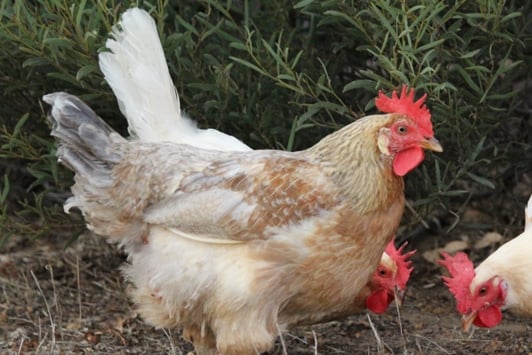Avian influenza is an infectious viral disease caused by strains of influenza A virus. It primarily affects birds.
Avian influenza strains are classified as low pathogenicity (LPAI) or high pathogenicity (HPAI) based on the severity of the disease they cause in poultry. HPAI infections are sometimes called "bird flu".
In Australia, LPAI strains are found in wild water birds. These strains do not usually cause disease in wild birds. Anseriformes (waterfowl: ducks, swans and geese) and Charadiformes (gulls, terns and shorebirds) are the natural reservoirs for avian influenza A viruses.
Avian influenza viruses are complex and are grouped by 2 surface proteins: haemagglutinin (HA) and neuraminidase (NA). For example, a virus that has HA 3 protein and NA 2 protein is known as subtype H3N2. At least 16 haemagglutinins (H1 to H16), and 9 neuraminidases (N1 to N9) subtypes have been found in viruses from birds.
Avian influenza is a zoonotic disease. If you handle sick or dead birds, it is recommended to use appropriate personal protective equipment (PPE).
About avian influenza
Signs of avian influenza vary in severity depending on the strain, and vary between different species of birds. They are often non-specific signs of illness.
In poultry signs of low or high pathogenicity avian influenza can include:
- sudden death
- lethargy or reluctance to walk, eat or drink
- droopy appearance or ruffled feathers
- respiratory signs (laboured breathing, coughing, sneezing, increased nasal secretions)
- dark, thickened or dropping combs and wattles
- swelling of the head or limbs
- conjunctivitis
- nervous signs (twisted neck, inability to stay upright, uncoordinated movement, circling, partial or full paralysis)
- diarrhoea
- decreased egg laying
- soft-shelled eggs.
Poultry usually show signs of avian influenza 2-14 days after being infected. In poultry, the signs of HPAI are usually more severe and sudden than the signs for LPAI.
Testing to rule out the presence of avian influenza must be done if poultry show the following:
Layers and breeders
- a 10% drop in egg production and/or
- the appearance of unexpected shell colour or shellless eggs in 5% or more of the eggs over a 2-3 day period and/or
- mortality of 0.5% per day or more for 3 or more days in any shed and/or
- any nervous or respiratory disease signs.
Broilers
- mortality (not including culling) of 0.5% per day or more for three days or more after the first week of placement and/or
- respiratory signs lasting more than two days and/or
- nervous signs regardless of the duration.
HPAI has occurred in poultry and backyard chickens in Australia, with 12 outbreaks of HPAI H7 viruses between 1976 and 2025.
HPAI H5 viruses have not been detected in animals in Australia. HPAI has never been detected in wild birds in Australia.
Occasionally, LPAI strains can infect poultry if the poultry:
- has contact with the saliva, nasal secretions and faecal material from wild birds infected with LPAI, or
- has contact with food, water, equipment or an environment contaminated by LPAI-infected wild birds.
People can spread the disease if they move sick or dead birds or use equipment that is not effectively cleaned between handling birds.
It is possible in certain circumstances for LPAI in poultry to mutate into HPAI.
To reduce the risk of avian influenza, it is important to keep wildlife away from poultry, poultry feed, water, and their housing environment.
Follow these biosecurity steps to reduce the risk:
- Use sheds, other secure enclosures or netting to keep poultry away from wild birds.
- Keep poultry feed and water containers under cover where wild birds and pests cannot access them.
- Prevent poultry accessing water sources used by wild birds.
- Sanitise river or dam water used for poultry as wild birds can contaminate this water. See the National water biosecurity poultry production manual for details.
- Ensure drainage in the poultry enclosure prevents pooling of water.
- Clean up feed spills immediately to discourage pests.
- Regularly clean and disinfect poultry feed and water containers, floors, walls and netting, equipment and carrying containers.
- Keep a record of visitors, limit access to poultry areas, and provide a footbath or clean footwear for visitors.
- Do not allow overseas visitors to have contact with poultry for a week after returning.
- Inspect poultry daily and isolate birds at the first signs of disease.
- Record and report unusual deaths, decreased production or unusual diseases to your veterinarian.
- Quarantine new birds for a minimum of 30 days (two incubation periods).
- Register as an owner of livestock with DPIRD. This is a requirement if you have 50 or more of any combination of chickens, turkeys, ducks, geese, quail, guinea fowl, pigeons or game birds.
Some endemic diseases can look similar to avian influenza such as acute fowl cholera, mycoplasma and respiratory disease complex.
Newcastle disease, which is exotic to Australia, can also look similar to avian influenza.
In the event of an avian influenza outbreak, health authorities advise properly cooked chicken meat and eggs are safe to eat. Always use good hygiene when handling raw meat and eggs.
Wild birds infected with LPAI generally show no disease signs.
Wild birds infected with HPAI may show neurological, respiratory and/or gastrointestinal signs or sudden death without prior signs. HPAI has never been detected in wild birds in Australia.
A new highly pathogenic strain H5N1 clade 2.3.4.4b (known as H5 avian influenza or H5 bird flu) is affecting wild birds and wild and domestic mammals across the world but has not yet reached Australia.

